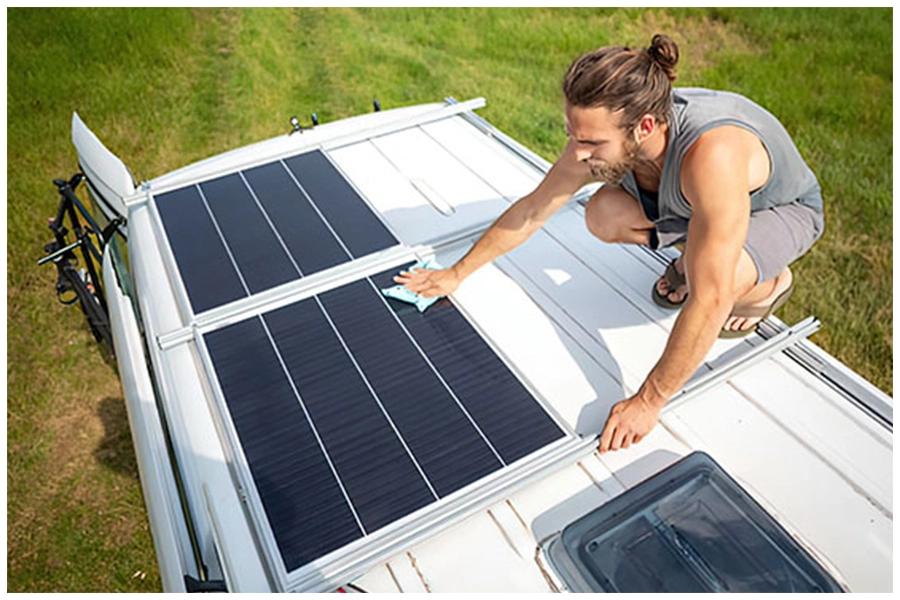How Portable Solar Modules Compare to Fixed Systems
It is in the efficiency of each of these systems, how they are constructed, and an understanding of how each system performs that will allow the user to make an ultimate choice between solar modules or fixed solar systems. In this paper, we delve in-depth into the technical PV cells, AC/DC conversion, and all the measurable benefits and drawbacks each system offers. We further step in to provide data-driven insights to support practical decision-making, whether you set up a solar-powered home or portable energy for outdoor adventures.
Overview of Solar Systems
Solar energy systems depend on photovoltaic conversion, a process whereby sunlight is directly converted into electricity. In fact, the same fundamental technology is used by both portable and fixed systems, but it is in the design, capacity, and intended use that each differs.
Most portable solar modules have smaller arrays and power output per panel within the range of 50W to 300W. Many of them come with folding kits or briefcase-type frames, making them very lightweight and easy to carry.
Fixed solar systems are larger in arrays, starting at 3 kW and going up to 10 kW. Such systems can be installed for residential or commercial purposes. Depending on the geographic location of the installation and weather conditions, a standard rooftop installation of 5 kW will produce anywhere between 20 to 30 kWh per day.
Although both systems produce DC electricity, portable modules often store energy in batteries, while fixed systems connect to grid-tied inverters that convert DC into AC for residential or commercial use. These differences play into efficiency, scalability, and applicability to specific uses.

Portability vs. Stability
Portability makes portable solar modules very different from other kinds of renewable energy. One portable panel, 100W weighing 4-6 kg, can already power small devices like lights or fans on a camping trip. These modules are ideal for RV owners, hikers, or any remote worker with off-grid energy needs.
Portable modules have a higher possibility of efficiency losses. They often capture sunlight at imperfect angles when laid flat on the ground or tent surfaces, reducing the energy output by up to 20-30% compared to an optimally installed panel.
Fixed systems offer several advantages in terms of stability and precision. Solar panels installed at a tilt equal to the latitude angle of the site optimize sunray capture in sunny climates. Fixed systems are also designed to withstand hail impact and 80-120 km/h winds, ensuring higher durability.
Studies have shown that fixed solar panels degrade at less than 1% per year, while portable solar panels degrade faster due to frequent handling and transportation.
Efficiency Differences
Fixed systems offer better efficiency and scalability in energy production compared to portable modules.
l Panel Efficiency: Monocrystalline solar panels used in fixed installations achieve 20-23% efficiency, among the highest available. Portable modules generally use polycrystalline cells, which are efficient at 15-18%, converting less sunlight to electricity.
l MPPT Technology: MPPT inverters in fixed installations extract 5-15% more energy than PWM controllers used in portable systems.
l Energy Generation: A 5 kW fixed installation in California can generate about 7,500 kWh annually, which meets the average American household’s consumption. A 500W portable setup provides around 2.5 kWh daily, enough to power small appliances and gadgets.
Relative Cost
The cost comparison between portable and fixed solar systems reveals significant differences.
l Portable Solar Kits:** Portable kits typically cost between $300-$1,500 depending on capacity. For example, a 200W kit with a battery pack and controller costs around $600.
l Fixed Installations:** A typical 5 kW rooftop system ranges between $15,000-$25,000, covering labor, inverters, and permits. Homeowners can recover the investment in 6-8 years through energy savings and net metering.
Over the long term, fixed systems offer better value. Over 25 years, a fixed system can generate 150,000 kWh, reducing the cost per kWh to $0.05-$0.08. Portable systems, with lower energy output and shorter lifespans, have a cost per kWh of $0.25-$0.30.
Installation Process
Portable solar modules are easy to set up. A 100W panel can be deployed in minutes, and users can adjust it during the day for optimal sunlight capture. This convenience is helpful for those on the move but less practical for consistent home power needs.
Portable setups often lack advanced safety features. Poorly connected batteries or inverters may pose risks, such as fires or explosions.
Fixed installations require professional assessment and installation. Installers analyze roof orientation, tilt angles, and shading patterns before placing the panels. The entire process takes 2-5 days but results in a more reliable system. Panels usually carry warranties of 20-25 years, and inverters have warranties of 10-15 years. Some prefer ground-mounted systems for more flexibility, though they require additional land.
Maintenance Requirements
Maintenance plays a crucial role in the lifespan of solar systems.
l Portable Systems: Due to frequent handling, portable systems may suffer from cracked glass or bent frames. They often use lithium-ion batteries, which last 5-7 years before losing capacity. Users must monitor batteries carefully to avoid overcharging or deep discharge.
l Fixed Solar Systems: Maintenance involves cleaning dust and bird droppings off the panels, which, if neglected, can reduce energy output by 5-10%. After 10-12 years, inverters may need replacement, costing $2,000-$3,000. However, overall maintenance costs are low, averaging $300-$500 per year.
Best Use Cases
Portable systems excel in off-grid and mobile applications. A 200W portable kit with a 100Ah battery can power essential devices like smartphones, laptops, and mini-fridges during camping trips. They are also effective for emergency preparedness during grid outages.
Fixed systems are ideal for residential, commercial, and industrial applications. A 5 kW rooftop system can generate 500-800 kWh per month, significantly reducing electricity bills. Businesses with high energy needs can install systems as large as 100 kW, saving thousands of dollars annually through net metering and energy credits.
Fixed systems also integrate well with energy storage solutions, enabling users to store excess power or feed it back into the grid for additional savings.